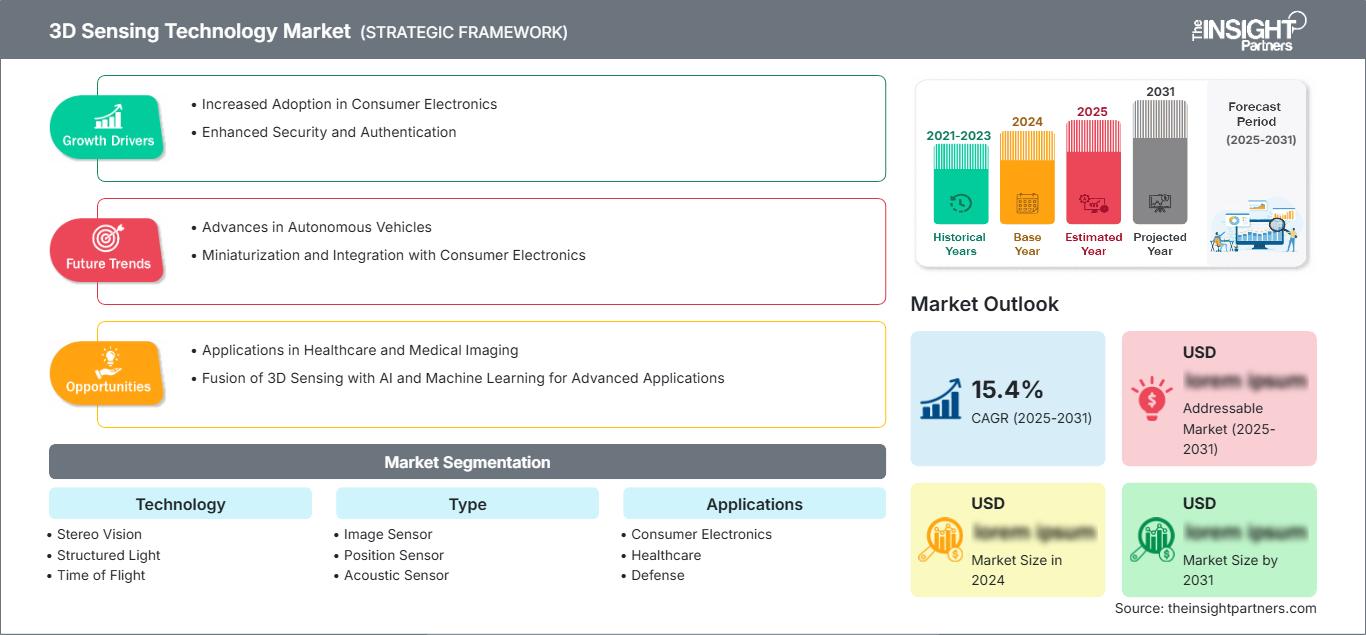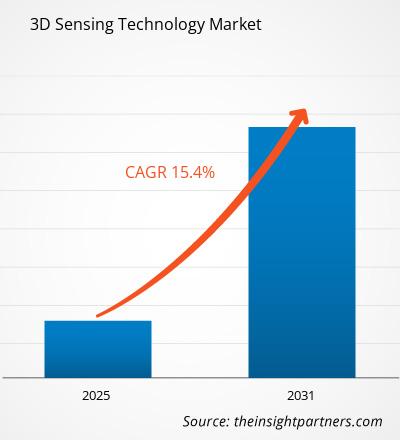Der Markt für 3D-Sensortechnologie wird voraussichtlich zwischen 2025 und 2031 eine durchschnittliche jährliche Wachstumsrate (CAGR) von 15,4 % verzeichnen, wobei die Marktgröße von XX Millionen US-Dollar im Jahr 2024 auf XX Millionen US-Dollar im Jahr 2031 anwachsen wird.
Der Bericht ist nach Technologie (Stereovision, Strukturiertes Licht, Time of Flight, Ultraschall); Typ (Bildsensor, Positionssensor, Akustiksensor, Beschleunigungssensor, CMOS-3D-Bild, Sonstige); Anwendung (Unterhaltungselektronik, Gesundheitswesen, Verteidigung, Industrierobotik, Unterhaltung, Automobil, Überwachung und Sicherheit, Sonstige) segmentiert. Die globale Analyse ist weiter auf regionaler Ebene und nach wichtigen Ländern aufgeschlüsselt. Der Bericht bietet den Wert in USD für die obige Analyse und Segmente.
Zweck des Berichts
Der Bericht „Markt für 3D-Sensortechnologie“ von The Insight Partners zielt darauf ab, die aktuelle Situation und das zukünftige Wachstum sowie die wichtigsten treibenden Faktoren, Herausforderungen und Chancen zu beschreiben. Dadurch erhalten verschiedene Geschäftsinteressenten Einblicke, beispielsweise:
- Technologieanbieter/-hersteller: Um die sich entwickelnde Marktdynamik zu verstehen und die potenziellen Wachstumschancen zu kennen, sodass sie fundierte strategische Entscheidungen treffen können.
- Investoren: Um eine umfassende Trendanalyse hinsichtlich der Marktwachstumsrate, der finanziellen Marktprognosen und der Chancen entlang der Wertschöpfungskette durchzuführen.
- Regulierungsbehörden: Um Richtlinien und Überwachungsaktivitäten auf dem Markt zu regulieren, mit dem Ziel, Missbrauch zu minimieren, das Vertrauen der Investoren zu wahren und die Integrität und Stabilität des Marktes aufrechtzuerhalten.
3D-Sensortechnologie Marktsegmentierung Technologie
- Stereovision
- Strukturiertes Licht
- Time of Flight
- Ultraschall
Typ
- Bildsensor
- Positionssensor
- Akustiksensor
- Beschleunigungssensor
- CMOS 3D-Bild
- Sonstige
Anwendungen
- Unterhaltungselektronik
- Gesundheitswesen
- Verteidigung
- Industrierobotik
- Unterhaltung
- Automobilindustrie
- Überwachung und Sicherheit
- Sonstige
Geografie
- Nordamerika
- Europa
- Asien-Pazifik
- Süd- und Mittelamerika Amerika
- Naher Osten und Afrika
Sie erhalten kostenlos Anpassungen an jedem Bericht, einschließlich Teilen dieses Berichts oder einer Analyse auf Länderebene, eines Excel-Datenpakets sowie tolle Angebote und Rabatte für Start-ups und Universitäten.
Markt für 3D-Sensortechnologie: Strategische Einblicke

- Holen Sie sich die wichtigsten Markttrends aus diesem Bericht.Dieses KOSTENLOSE Beispiel umfasst Datenanalysen, die von Markttrends bis hin zu Schätzungen und Prognosen reichen.
Wachstumstreiber für 3D-Sensortechnologie
- Zunehmende Nutzung in der Unterhaltungselektronik: Einer der wichtigsten Treiber des 3D-Sensormarktes ist die zunehmende Verwendung von 3D-Kameras und Tiefensensortechnologien in der Unterhaltungselektronik, insbesondere in Smartphones und Tablets. Apples Face ID beispielsweise nutzt 3D-Gesichtserkennung für die Sicherheit, und andere Hersteller ziehen nach und setzen 3D-Sensortechnologien ein, um das Benutzererlebnis zu verbessern.
- Verbesserte Sicherheit und Authentifizierung: Mit dem zunehmenden Fokus auf biometrische Sicherheitssysteme wird 3D-Sensortechnologie zur Gesichtserkennung in einer Vielzahl von Anwendungen eingesetzt. Dazu gehören Smartphones, Laptops, Zugangskontrollsysteme und Zahlungssysteme. 3D-Gesichtserkennung ist sicherer als 2D-Bildgebung, da sie mit Fotos oder Videos schwerer zu fälschen ist und eine kontaktlose Authentifizierung ermöglicht.
Zukünftige Trends im Markt für 3D-Sensortechnologie
- Fortschritte bei autonomen Fahrzeugen: Autonome Fahrzeuge und Fahrerassistenzsysteme sind in hohem Maße auf 3D-Sensortechnologien wie LiDAR, Radar und Tiefenkameras zur Umgebungskartierung und Objekterkennung angewiesen. Diese Sensoren helfen Fahrzeugen, ihre Umgebung zu verstehen, Hindernisse zu erkennen und die Sicherheit zu verbessern, was für die Weiterentwicklung autonomer Fahrtechnologien von entscheidender Bedeutung ist.
- Miniaturisierung und Integration mit Unterhaltungselektronik: Einer der wichtigsten Trends im 3D-Sensormarkt ist die Miniaturisierung von Sensoren, die ihre Integration in Unterhaltungselektronik wie Smartphones, Wearables und Spielkonsolen ermöglicht. Hersteller konzentrieren sich darauf, die Größe von 3D-Sensorkomponenten zu reduzieren und gleichzeitig ihre Leistung zu verbessern, um sie kostengünstiger und effizienter zu machen. Dieser Trend erweitert die Anwendbarkeit von 3D-Sensortechnologien in Alltagsgeräten, beispielsweise für die Gesichtsentsperrung von Smartphones oder erweiterte Kamerafunktionen, und macht sie so für den Massenmarkt zugänglicher.
Marktchancen für 3D-Sensortechnologie
- Anwendungen im Gesundheitswesen und in der medizinischen Bildgebung: 3D-Sensortechnologie revolutioniert die medizinische Bildgebung, wo sie für 3D-Scans, Bildgebungssysteme und Diagnosewerkzeuge eingesetzt wird. 3D-Ultraschall, CT-Scans und MRT-Bildgebung profitieren alle von 3D-Sensorik, um medizinischem Fachpersonal genauere, umfassendere Daten in Echtzeit zu liefern.
- Fusion von 3D-Sensorik mit KI und maschinellem Lernen für fortschrittliche Anwendungen: Die Kombination von 3D-Sensortechnologie mit künstlicher Intelligenz (KI) und maschinellem Lernen (ML) revolutioniert Anwendungen in verschiedenen Branchen. KI- und ML-Algorithmen ermöglichen die Analyse und Interpretation komplexer 3D-Daten und verbessern die Genauigkeit bei Gesichtserkennung, Gestenverfolgung und Umgebungskartierung. Diese Integration verbessert die Entscheidungsfindung in Echtzeit und ermöglicht intelligentere, adaptive Systeme in Anwendungsbereichen von Einzelhandel und Marketing bis hin zu industrieller Automatisierung und Robotik. Mit der Weiterentwicklung von KI- und ML-Technologien wird ihre Synergie mit 3D-Sensorik neue Möglichkeiten und Anwendungen eröffnen.
Markt für 3D-Sensortechnologie
Die Analysten von The Insight Partners haben die regionalen Trends und Faktoren, die den Markt für 3D-Sensortechnologie im Prognosezeitraum beeinflussen, ausführlich erläutert. In diesem Abschnitt werden auch die Marktsegmente und die geografische Verteilung der 3D-Sensortechnologie in Nordamerika, Europa, dem asiatisch-pazifischen Raum, dem Nahen Osten und Afrika sowie Süd- und Mittelamerika erörtert.Umfang des Marktberichts zur 3D-Sensortechnologie
| Berichtsattribut | Einzelheiten |
|---|---|
| Marktgröße in 2024 | US$ XX million |
| Marktgröße nach 2031 | US$ XX Million |
| Globale CAGR (2025 - 2031) | 15.4% |
| Historische Daten | 2021-2023 |
| Prognosezeitraum | 2025-2031 |
| Abgedeckte Segmente |
By Technologie
|
| Abgedeckte Regionen und Länder | Nordamerika
|
| Marktführer und wichtige Unternehmensprofile |
|
Dichte der Marktakteure für 3D-Sensortechnologie: Verständnis ihrer Auswirkungen auf die Geschäftsdynamik
Der Markt für 3D-Sensortechnologie wächst rasant. Die steigende Nachfrage der Endnutzer ist auf Faktoren wie veränderte Verbraucherpräferenzen, technologische Fortschritte und ein stärkeres Bewusstsein für die Produktvorteile zurückzuführen. Mit der steigenden Nachfrage erweitern Unternehmen ihr Angebot, entwickeln Innovationen, um den Bedürfnissen der Verbraucher gerecht zu werden, und nutzen neue Trends, was das Marktwachstum weiter ankurbelt.

- Holen Sie sich die Markt für 3D-Sensortechnologie Übersicht der wichtigsten Akteure
Wichtige Verkaufsargumente
- Umfassende Abdeckung: Der Bericht analysiert umfassend Produkte, Dienstleistungen, Typen und Endnutzer des Marktes für 3D-Sensortechnologie und bietet einen ganzheitlichen Überblick.
- Expertenanalyse: Der Bericht basiert auf dem umfassenden Verständnis von Branchenexperten und Analysten.
- Aktuelle Informationen: Der Bericht gewährleistet Geschäftsrelevanz durch die Berichterstattung über aktuelle Informationen und Datentrends.
- Anpassungsoptionen: Dieser Bericht kann an spezifische Kundenanforderungen angepasst werden und passt sich optimal an die Geschäftsstrategien an.
Der Forschungsbericht zum Markt für 3D-Sensortechnologie kann daher dazu beitragen, die Branchensituation und die Wachstumsaussichten zu entschlüsseln und zu verstehen. Obwohl es einige berechtigte Bedenken geben mag, überwiegen die Vorteile dieses Berichts tendenziell die Nachteile.
- Historische Analyse (2 Jahre), Basisjahr, Prognose (7 Jahre) mit CAGR
- PEST- und SWOT-Analyse
- Marktgröße Wert/Volumen – Global, Regional, Land
- Branchen- und Wettbewerbslandschaft
- Excel-Datensatz
Aktuelle Berichte
Verwandte Berichte
Erfahrungsberichte
Grund zum Kauf
- Fundierte Entscheidungsfindung
- Marktdynamik verstehen
- Wettbewerbsanalyse
- Kundeneinblicke
- Marktprognosen
- Risikominimierung
- Strategische Planung
- Investitionsbegründung
- Identifizierung neuer Märkte
- Verbesserung von Marketingstrategien
- Steigerung der Betriebseffizienz
- Anpassung an regulatorische Trends






















 Kostenlose Probe anfordern für - Markt für 3D-Sensortechnologie
Kostenlose Probe anfordern für - Markt für 3D-Sensortechnologie